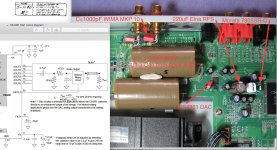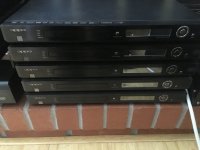I like this particular model Oppo DV-980H DVD player, as it has a pretty good picture for a DVD player, good upconverter to 1080p, HDMI output, and a USB socket on the front for playing MP3s. It also plows through most CD's, CD-R's, and DVD's almost no matter the damage. And one can pick them up pretty cheap on craigslist, so now I have four. Can't have too many spare parts right?
This mod is NOT quite housebroken as it lets loose a nasty thump every time it's switched off. My own woofers are real tough, but buyer beware.
So next time I try this mod, I will look into using the on-board muting circuit. Also my thump is made worse by the large 7.6uF caps I'm using, as Cirrus calls for 3.3uF.
Thanks to GaryB for pointing this out: The datasheet for the CS4361 shows how to connect it so that it requires no opamps. Use Fs=192000 and Rext=5000 in the equation below the diagram (attached), and C=10x10^-10 = 1000pF.
Output is lower than the stock 2V, I'm guessing about 6dB lower, so just over 1 volt? I'll measure one day.
I'm also using a switching regulator Murata 7805SR (~$10) for the 5V to the DAC.
This mod is NOT quite housebroken as it lets loose a nasty thump every time it's switched off. My own woofers are real tough, but buyer beware.
So next time I try this mod, I will look into using the on-board muting circuit. Also my thump is made worse by the large 7.6uF caps I'm using, as Cirrus calls for 3.3uF.
Thanks to GaryB for pointing this out: The datasheet for the CS4361 shows how to connect it so that it requires no opamps. Use Fs=192000 and Rext=5000 in the equation below the diagram (attached), and C=10x10^-10 = 1000pF.
Output is lower than the stock 2V, I'm guessing about 6dB lower, so just over 1 volt? I'll measure one day.
I'm also using a switching regulator Murata 7805SR (~$10) for the 5V to the DAC.
Attachments
Hi Andersonix,
Why not install a relay muting circuit? Of course, I'm trying to figure out why anyone would risk exposing the DAC to the outside world. A good op amp buffer provides protection as well as better drive for dealing with the outside world. There are op amps that will operate at lower noise and distortion levels than most other pieces of equipment does. And in that light they provide a benefit to the sound quality.
-Chris
Why not install a relay muting circuit? Of course, I'm trying to figure out why anyone would risk exposing the DAC to the outside world. A good op amp buffer provides protection as well as better drive for dealing with the outside world. There are op amps that will operate at lower noise and distortion levels than most other pieces of equipment does. And in that light they provide a benefit to the sound quality.
-Chris
"Design by ear" is not the way to improve anything, you need measurements as well. Case in point. Tube preamp sounds pretty good when it comes here. Then I measure it and it has 1% THD at 1 V output. Unacceptable. This was from a designer who does design by ear. Later on, the new owner tired of the sound and is trying to sell it on. I warned him.
You can do this yourself if you wish. Just don't ask others to follow your path, and don't sell modified equipment to anyone else. That way they don't have to pay to clean up the mess.
-Chris
You can do this yourself if you wish. Just don't ask others to follow your path, and don't sell modified equipment to anyone else. That way they don't have to pay to clean up the mess.
-Chris
Hi Andersonix,
Thanks, found it.
Did you include the output network, and have you looked at the loading on the output? I would think that their concern over loading internally would go (at least) double for direct connection to the outside world! There are a few op amps that have lower distortion and noise than the DAC has. Properly implemented, they would very likely improve the sound quality.
One thing I find striking is the lack of a reconstruction filter. They say it has been implemented on the chip, but I would want to check this anyhow. At -94 dB S/N, there are a lot of op amps that would suite this chip and provide the ability to properly drive cable reactance and the following input stage. Often times an output buffer will improve the performance of the output circuit in the D/A by unloading it. Without such a buffer, the performance would certainly depend on the load, including cables. You can expect the high frequencies to suffer first, and this may actually be why you prefer that configuration.
-Chris
Thanks, found it.
Did you include the output network, and have you looked at the loading on the output? I would think that their concern over loading internally would go (at least) double for direct connection to the outside world! There are a few op amps that have lower distortion and noise than the DAC has. Properly implemented, they would very likely improve the sound quality.
One thing I find striking is the lack of a reconstruction filter. They say it has been implemented on the chip, but I would want to check this anyhow. At -94 dB S/N, there are a lot of op amps that would suite this chip and provide the ability to properly drive cable reactance and the following input stage. Often times an output buffer will improve the performance of the output circuit in the D/A by unloading it. Without such a buffer, the performance would certainly depend on the load, including cables. You can expect the high frequencies to suffer first, and this may actually be why you prefer that configuration.
-Chris
Yes I added the two resistors and two caps as shown in the diagram, but no I haven't checked anything.Did you include the output network, and have you looked at the loading on the output?
Hi Andersonix,
Check best that you can. It would be interesting to see how much of a voltage drop there was when you connect this to the preamp. If you have a test CD with a constant tone, it would be easy to check. You would want to use either an AC voltmeter (not a DVM unless it was like an HP 34401A or equivalent), or an oscilloscope. One of the newer digital ones might be better in this case.
Best, Chris
Check best that you can. It would be interesting to see how much of a voltage drop there was when you connect this to the preamp. If you have a test CD with a constant tone, it would be easy to check. You would want to use either an AC voltmeter (not a DVM unless it was like an HP 34401A or equivalent), or an oscilloscope. One of the newer digital ones might be better in this case.
Best, Chris
Hi synchron,
You may as well go to a desert island then. Most everything is processed by some kind of op amp. There are op amps that best discrete designs too, so I don't know where you're coming from.
I work with op amps quite often, as well as discrete designs and really can't find anything wrong with a well designed op amp circuit. I would have to say that your training has been terribly remiss.
-Chris
You may as well go to a desert island then. Most everything is processed by some kind of op amp. There are op amps that best discrete designs too, so I don't know where you're coming from.
I work with op amps quite often, as well as discrete designs and really can't find anything wrong with a well designed op amp circuit. I would have to say that your training has been terribly remiss.
I guess they need something to be critical over, and a simple discrete op amp would do it.that's why critical audio people build simple discrete "op-amps".
-Chris
- Home
- Source & Line
- Digital Source
- Mod for Oppo DV-980H: direct output from CS4361 DAC

